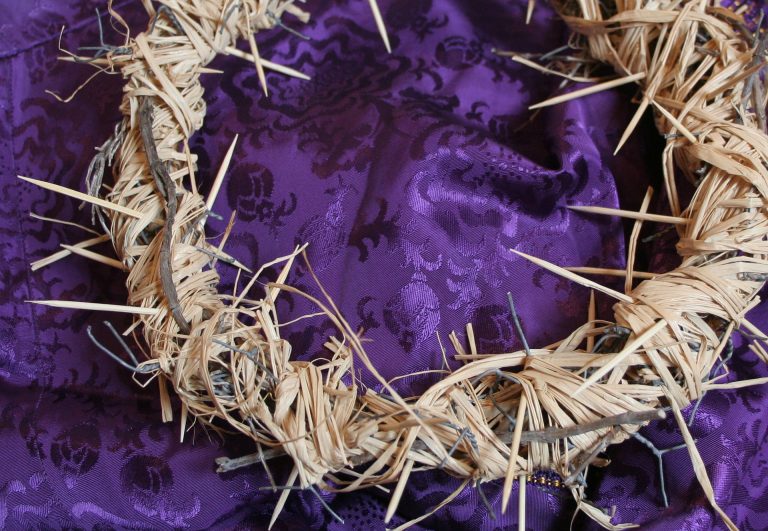Lent is a 40 day period observed by Catholics in preparation for Easter. Rich with symbolic customs imbued with spiritual significance, Lent begins on Ash Wednesday, when observant Catholics embark on a journey of sacrifice to cleanse their souls of sin and strengthen their faith.
The symbolism of Lent is not always readily apparent. Some of the terminology and practices may seem oddly chosen for this solemn time, but by examining their roots, we can derive a clearer understanding and respect for the faithful.
What was Christ’s Passion?
The Passion of Christ is a term often used in the Church. Passion in this sense is not at all what we have come to understand in modern language. The word stems from the latin pati, meaning “to endure” or “to suffer.” Thus, Christ’s passion was the suffering he endured during the persecution leading up to and including his crucifixion.

What does “Lent” mean?
The word Lent comes from the Old English word lencten, which referred to the lengthening of days that occurs in the spring, which happens to coincide with the penitential period of the church officially called “quadragesima,” meaning 40 days, in Latin.
The number 40 appears frequently in the bible, and is connected with a time of prayer and sacrifice. Forty was the duration in days of the great flood, the number of years the people of Israel were to wander the desert as punishment for disobeying God, and the number of days Elijah fasted while traveling to hear God’s word. Jesus himself was engaged in a 40 day spiritual battle before taking up his ministry. After he was baptized, he was led into the wilderness and tempted by the devil, fasting for 40 days.
Success
You are now signed up for our newsletter
Success
Check your email to complete sign up
The word Lent may have been easier to say and remember than quadragesima, but it also has powerful relevance; since the spring season is universally seen as a time of renewal and rebirth. We can thus understand Lent to be a time of spiritual renewal, when the soul is cleansed and restored.

Significance of Ash Wednesday
To understand Ash Wednesday, we must first have a look at Palm Sunday. This holy day is celebrated as marking Jesus’ triumphant entry into Jerusalem, where he was welcomed with palm leaves within a week of his death. The large, evergreen, fan-like leaves symbolize goodness and victory, and they are used to both begin, and end, the lenten period; making the spiritual observance continual and complete.
On Palm Sunday, palms are distributed in churches, blessed, used in processionals, and made into small crosses. The blessed palms are burned the following year on Shrove Tuesday to be used on Ash Wednesday. Ashes were often used as a sign of repentance, and applied when seeking mercy from God.
Ash Wednesday is the beginning of Lent. It is a moveable holy day that comes 46 days before Easter Sunday (40 days plus the Sundays which aren’t counted). Catholics who attend Mass or a prayer service on this day will receive a cross of palm ash on their forehead as a reminder of human mortality, the consequence of Adam and Eve’s original sin. The well known phrase “ashes to ashes, dust to dust,” originates from the Bible, and means that we are made of dust and will return to dust upon death.
Wednesday is significant because it is the day Jesus’ disciple Judas is believed to have betrayed Him, by identifying Jesus with a kiss before those who would arrest and persecute him. Directly linked to Christ’s Passion, Ash Wednesday is a fasting day meant to atone for this betrayal as well as the frequent bad choices one makes in everyday life.

Fasting and “fish Friday”
Christ is believed to have died on the cross on a Friday, so this day has long been recognized as a day for Christians to unite with Jesus in his suffering through fasting. The tradition of abstinence focused on meat.
Since meat was once reserved for feasts and celebrations, it was considered a sacrifice to abstain from animal flesh. Fish, however, was not prohibited. Only “land animals,” including birds, counted as meat, so fish became a common entree on Fridays. Today, it may seem more appropriate to abstain from fish as well, as it is now regarded as a special, or celebratory dish.
The main idea is for the faithful to offer a sacrifice to God from the heart, in order to become closer to Christ in his ultimate sacrifice. As taught in many spiritual practices, giving up human attachments brings you closer to the Divine.
Not only Ash Wednesday and Good Friday, but all Wednesdays and Fridays were traditionally considered fasting days. This was in part to counteract the sinful behavior tolerated by pagans, who dedicated Wednesday to Mercury, the god of theft and injustice, and Friday to Venus, goddess of carnal love and debauchery; thus reminding Christians not to partake in such activities.

Symbolism of color
Why is it customary for Catholic priests to wear purple during the penitential season of Lent?
In ancient times, dye for the color violet, or purple, was obtained by extracting the mucus from a rare sea snail (Bolinus brandaris) and exposing it to sunlight for a specific amount of time. To make one ounce of dye required cracking 250,000 of these rare snails, making it quite precious and “fit for a king.” The color became associated with royalty and some rulers even forbade their subjects from wearing purple.
When the Romans were persecuting Jesus, they dressed him in purple robes and a crown of thorns to mock him and those who called him their king. As the color became keenly associated with Christ’s passion, and the link with royalty faded; the color was adopted to symbolize repentance and preparation during Lent. The color is also used during Advent as a symbol of anticipation.
Persecuted for faith in the Divine
All of Jesus’s apostles were persecuted as well; most of them killed with horrific violence. The persecution of Christians under the Roman Empire continued until the 4th century AD; yet the Christians were not the first to be persecuted for their faith, nor were they the last. Whenever a great prophet has come to the earth to preach morality and offer salvation to people, there have been parties of unbelievers bent on attacking the faithful.
Falun Gong practitioners in China today have endured brutal persecution since July 20, 1999, when the Chinese Communist Party under Jiang Zemin launched a massive campaign to destroy the peaceful practice. Initially promoted by the government as a high-level qigong practice, Falun Gong became so widely popular that Jiang found it threatening and gave orders to “Destroy their reputations, cut them off financially, and eradicate them physically,” using the state-run propaganda machine as well as all necessary government facilities.
While this spiritual discipline has brought health and well-being to millions of people who practice freely around the world, the CCP continues to arrest, torture, and kill kindhearted people whose hearts have aligned with the heavenly principles of Truthfulness, Compassion, and Forbearance.















